Want to track the performance of your Google Ads campaigns in Google Analytics and WordPress? By enabling Google Ads conversion tracking in Google Analytics and connecting it with your WordPress website, you can see what happens after people interact with your ads.
For example, you’ll be able to track whether they made a purchase after clicking your ad link, signing up for your newsletter, or completing another type of conversion.
In this article, we’ll show you how to use Google Analytics to track conversions from ad campaigns you run on the Google Ads (formerly known as AdWords) platform.
Ads Conversion Tracking Video Walkthrough
What Is Google Ads Conversion Tracking?
Google Ads conversion tracking tells you what visitors do on your site after clicking your online ads. It tells you whether people completed an action that you’ve defined as valuable.
Conversion tracking for your ads is important because it tells you whether your ad campaigns are paying off, or if they’re wasting your advertising budget.
A few benefits of Google Ads conversion tracking are:
- Identify which keywords, ads, ad groups, and campaigns are the most profitable.
- Make informed decisions on which ads to spend more money on.
- Gain insights into how to optimize your ads for boosting return on investment (ROI).
By setting up conversion tracking on your WordPress site, you can identify how effective your ad clicks are at leading customers to a conversion on your website, such as product purchases, form submissions, and more.
How to Add Google Ads Tracking to Your WordPress Site
Just follow these steps to add Google Ads conversion tracking to WordPress.
Step 1: Install and Activate MonsterInsights
MonsterInsights is the best Google Analytics plugin for WordPress, and it can set up Google Ads and track conversions for you in just a couple of clicks. Plus, you get tons of other advanced Google Analytics tracking features like form tracking, Meta Ad tracking, video tracking, outbound link click tracking, and so much more.
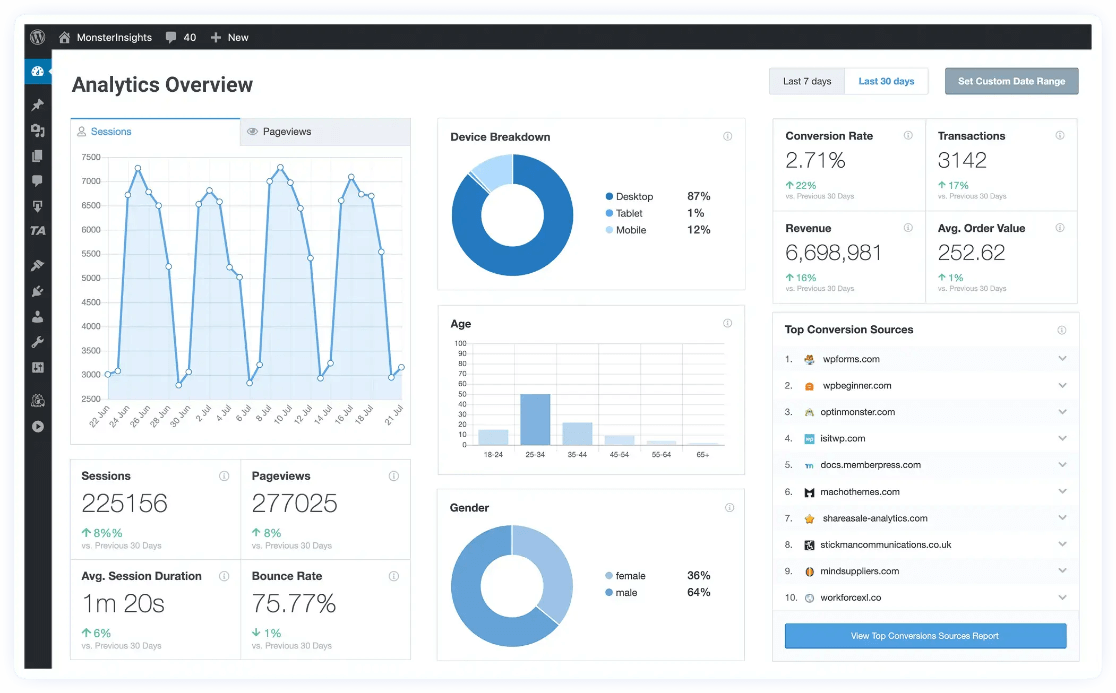
Start by installing MonsterInsights at the Pro level on your website. After you get the license, you can download the plugin from your Account area, under the Downloads tab.
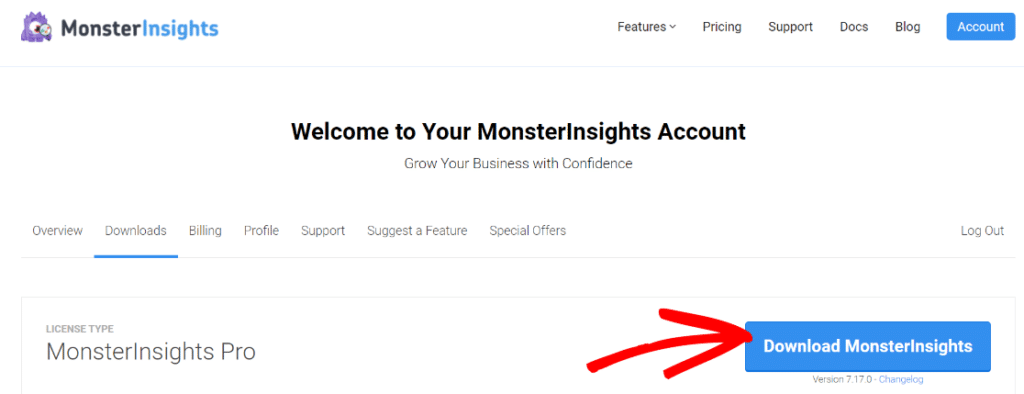
Next, go to your WordPress website and upload the plugin by going to Plugins » Add New » Upload Plugin.
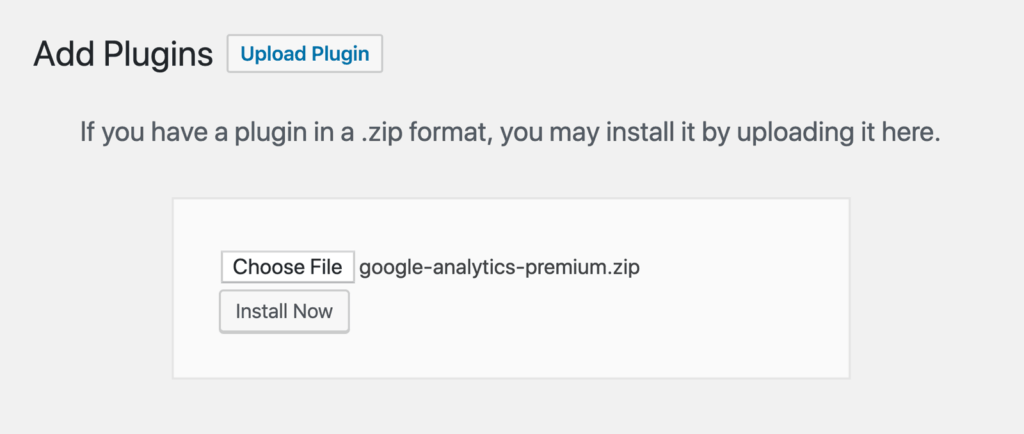
Once that’s done, install and activate MonsterInsights on your website.
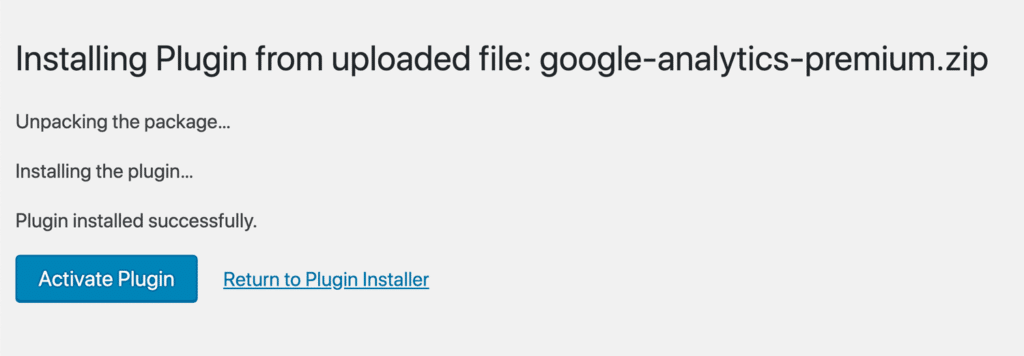
Step 2: Connect Google Analytics using MonsterInsights
Next, connect Google Analytics with your WordPress website. MonsterInsights helps set up analytics without the need to hire a developer or write code.
Simply use its setup wizard and follow the steps to add Google Analytics tracking code.
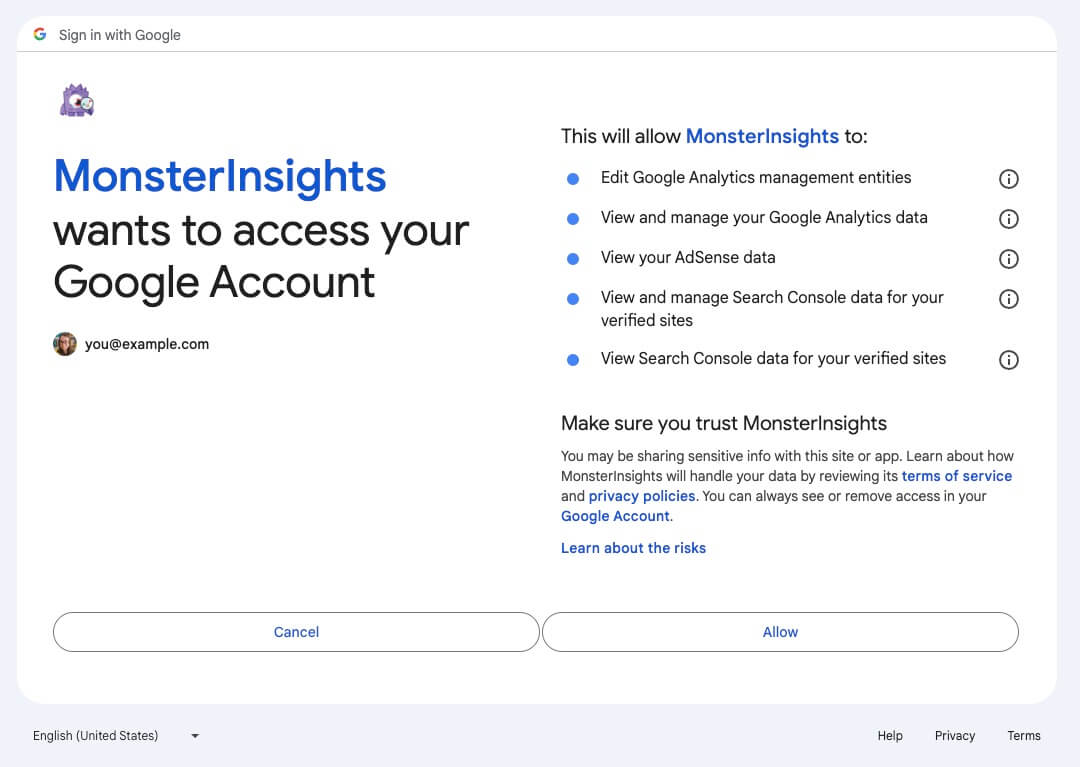
Step 3: Install MonsterInsights PPC Tracking Addon
After that, you’ll need to install and activate the PPC Ads addon. Make sure you’re on MonsterInsights Pro or higher plan to use the addon.
To install the addon, go to Insights » Addons and click the Install button for the PPC Tracking addon. Now wait for a few seconds and it will automatically activate.
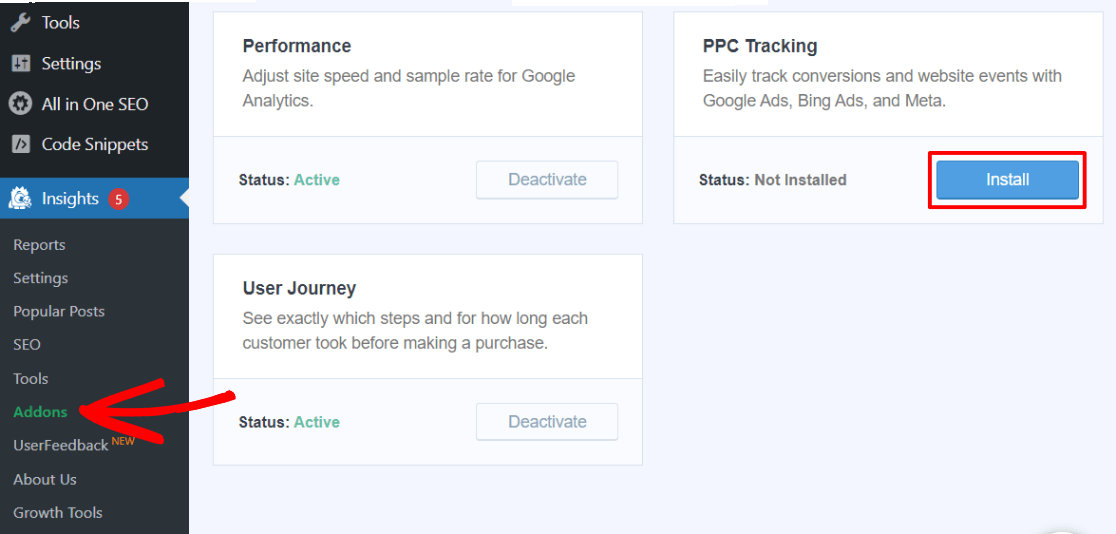
Step 4: Create a Conversion Action
To start, sign in to your Google Ads account. In the navigation on the left side, hover over Goals, expand Conversions, and click Summary. NOTE: If you don’t see this option, go to Settings » Switch to expert mode (see screenshot).
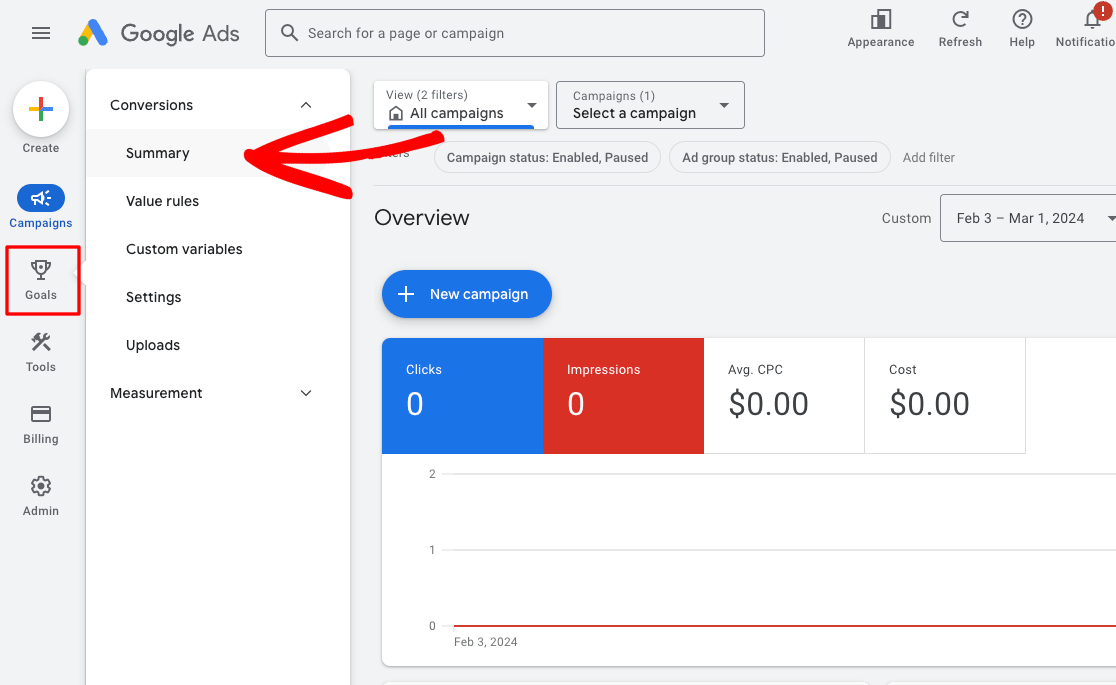
Then, click the + New conversion action button.
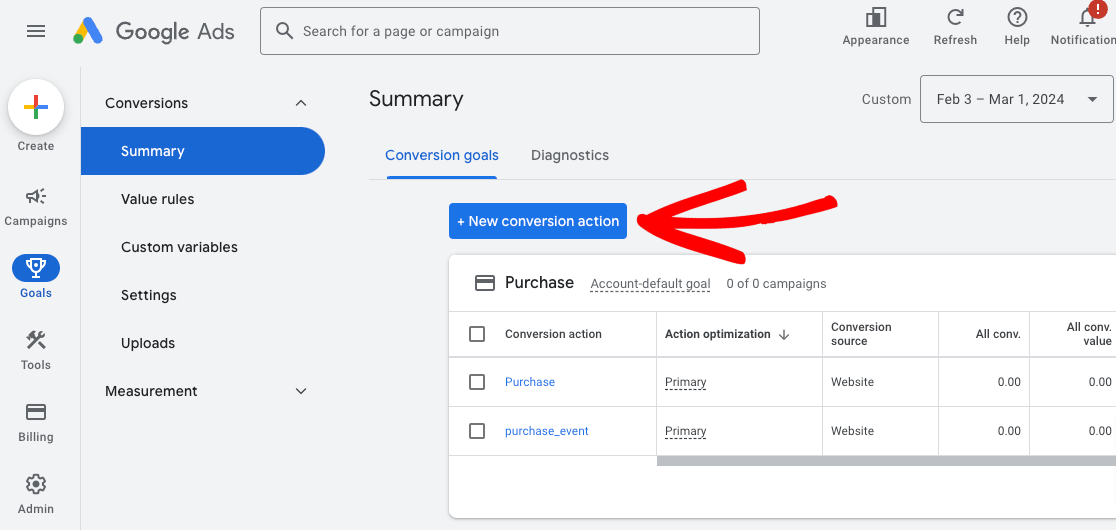
Next, click Website.

Now, Google will scan your website to see if it’s configured for conversion tracking. Enter your site domain and click Scan.
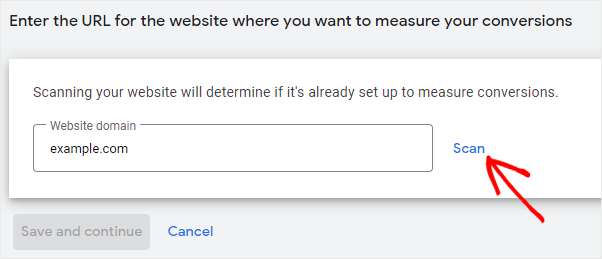
Then, Google Ads will ask whether you want to create a conversion action Automatically or Manually. NOTE: If you see an option that says “Measure in Google Analytics,” do not click it. Continue with a manual conversion action. You need to select the manual option by clicking + Add a conversion action manually

Now, you’ll select a Goal, enter a Conversion name, and specify a Value for that conversion.
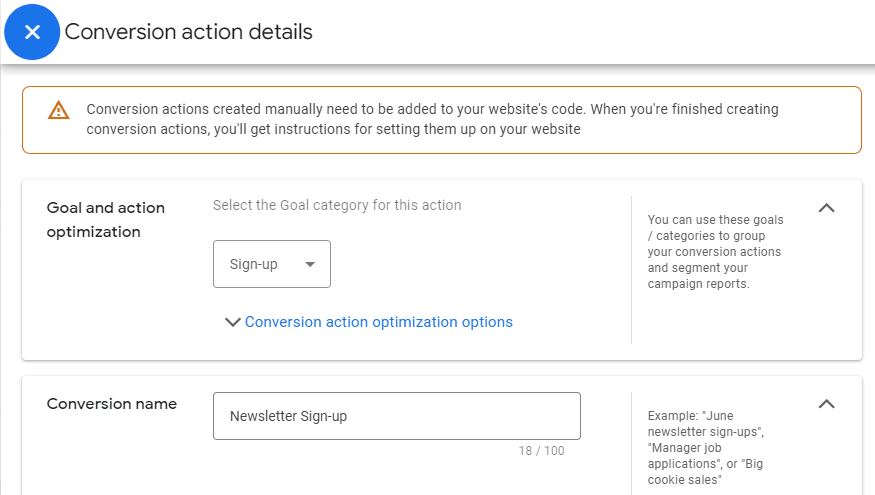
We’re going to use the same conversion value for each conversion, and set our Count to One so that a subscriber is only counted as a conversion once. For purchase conversions you’ll normally want to set this to Every in order to count each purchase as a conversion.
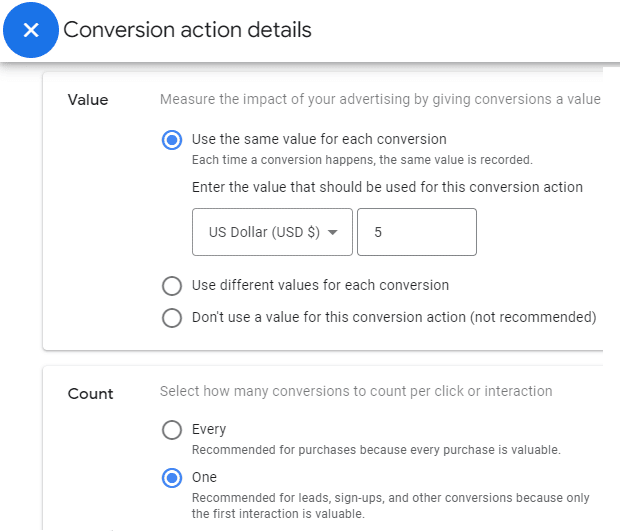
Then, click Done. Now, we’ve created a new conversion in Google Ads named Newsletter Sign-up. This should track everyone who signs up for our newsletter and assign a value of $5 to each of these sign-ups.
At this point, click the Save and continue button to get instructions to add the tracking tag for this conversion to your website. Then you’ll click on the Use Google Tag Manager option.
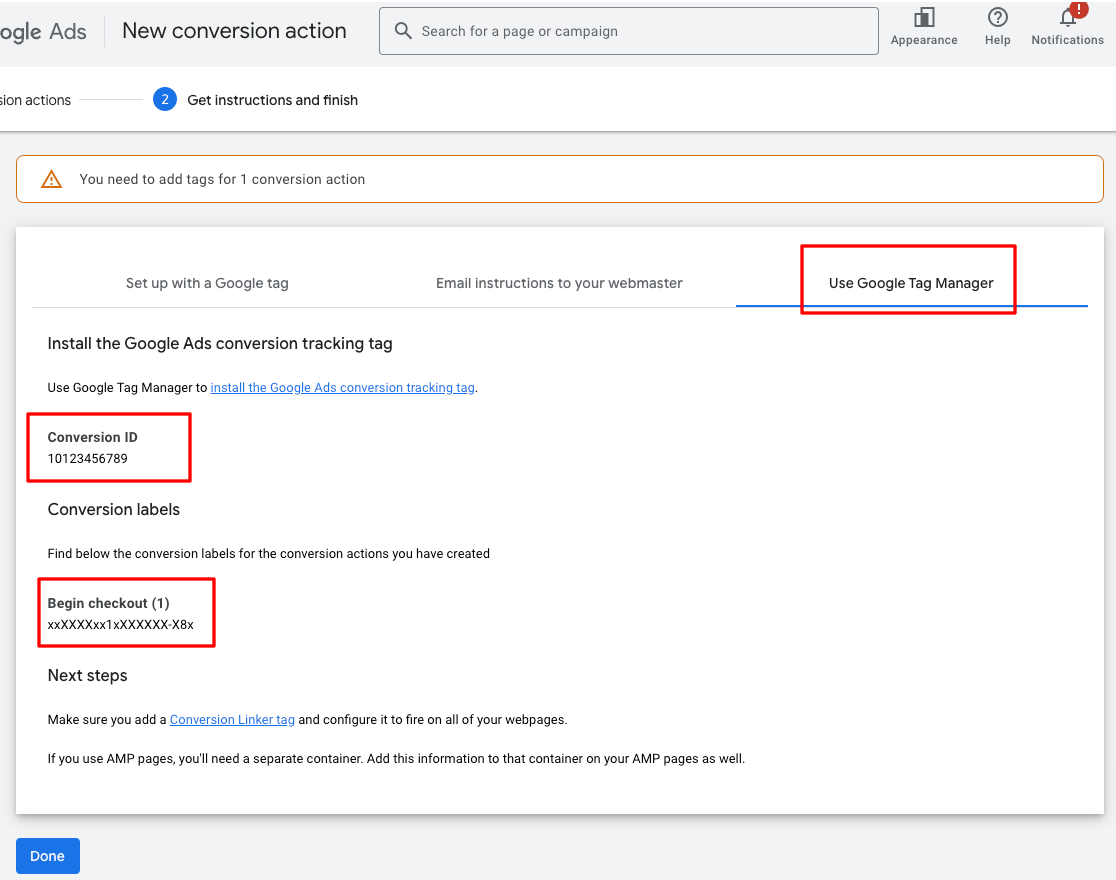
You will now see the Conversion ID and Conversion Label that you’ll need to finish setting up tracking. Copy and save these, or just leave this window open and move onto the next step.
Step 5: Add Your Google Ads Conversion ID and Conversion Label
The next step is to add your Google Ads Conversion ID (and Conversion Label if required) in MonsterInsights.
Go back to your open Google Ads tab and copy your Conversion ID. It will be a 9-digit code with the format AW-123456789 or 123456789.
After copying the ID, go to Insights » Settings » Conversions in MonsterInsights and navigate to Ads Tracking. Paste your Conversion ID into the field.
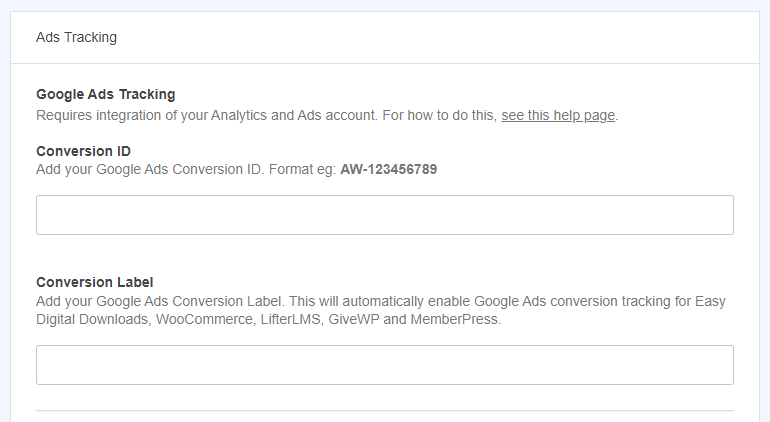
Now, if you’re using WooCommerce, Easy Digital Downloads, MemberPress, LifterLMS, or GiveWP you need to also copy and paste your Conversion Label from Google Ads into the Conversion Label field in MonsterInsights.
MonsterInsights uses Google’s newest tracking technology, called enhanced conversions.
Step 6: Add the Event Snippet to the Conversion Page
NOTE: You can skip this step if you’re using WooCommerce, Easy Digital Downloads, MemberPress, LifterLMS, or GiveWP and you’ve pasted your Conversion Label into MonsterInsights.
Head back to your Ads tab and click the Back button. Now, click on the Install the tag yourself option:
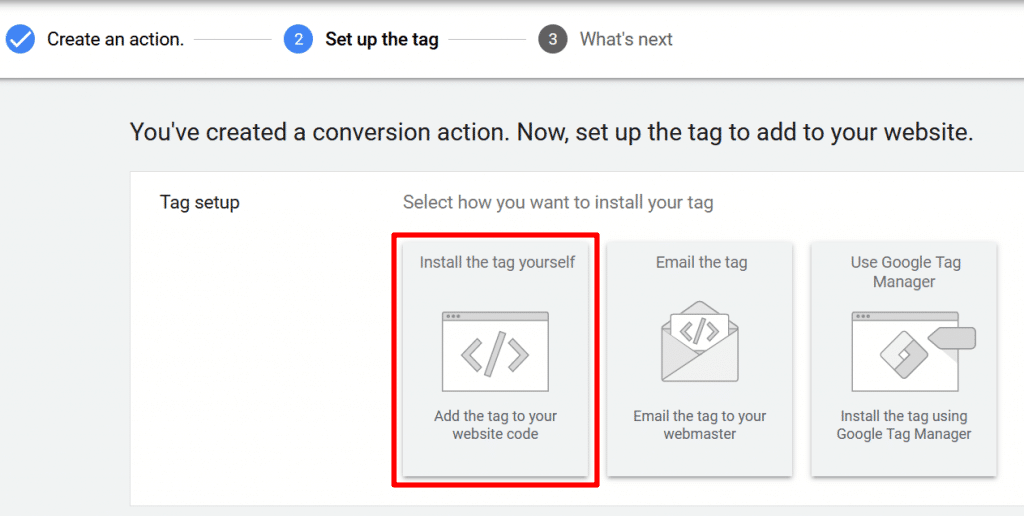
Scroll down to the Event snippet:
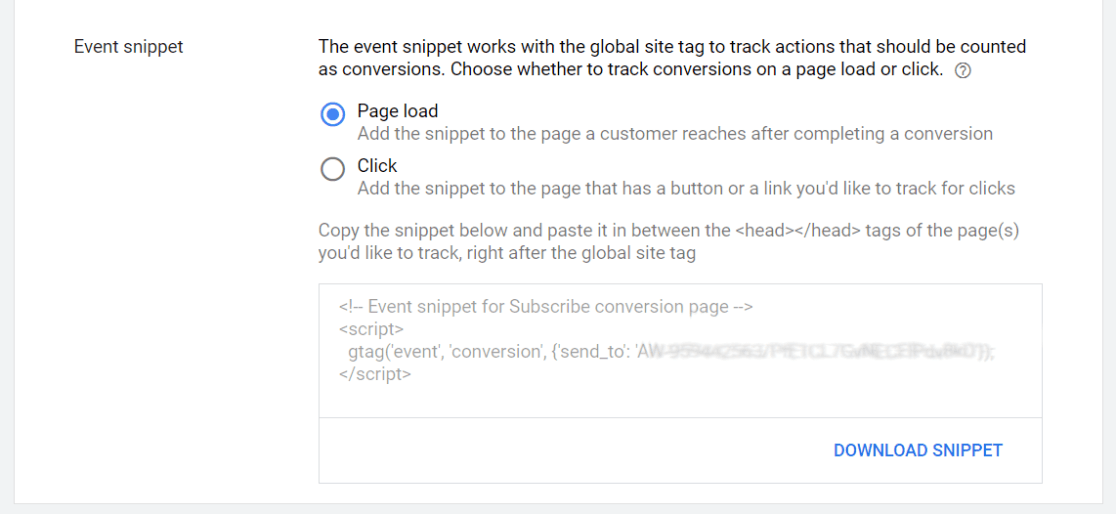
If your conversion is on a destination page, such as yoursite.com/thank-you, you’ll add the snippet to that page. If your conversion is a click, like on a “download now” button, you’ll add your snippet to the page that the button is on.
While Google Ads suggests putting the code in the header, it can also work to put it at the top of the HTML of the page in your WordPress page editor. You could also use a plugin to insert the code in the header on a specific page.
Congrats! You’ve successfully set up Google Ads conversion tracking on your WordPress site.
Why Should You Link Google Analytics With Google Ads?
If you’ve set up Google Analytics on your WordPress site, your Analytics account will already have an abundance of customer interaction data. If you want to make use of your Analytics data to better track the interaction of the customers you acquired through the ads campaign, you need to link your Analytics account with Google Ads.
Some more benefits of linking Google Analytics with Google Ads are:
- See your ad performance report in Google Analytics along with other site data.
- Import Google Analytics metrics, goals, and eCommerce transactions into your Google Ads account.
- Get richer data in the Analytics Multi-Channel Funnels report.
How to Link Google Ads with Google Analytics 4
Now we’ll show you how to link Google Ads with Google Analytics 4 (GA4), the most recent version of Google’s analytics platform.
First, log in to GA4 and select the property that you want to link to your Google Ads account. Then click the Admin icon in the left menu.
Now, click on Google Ads Links item in the right-hand column. Then, on the next screen you’ll click the Choose Google Ads accounts button.
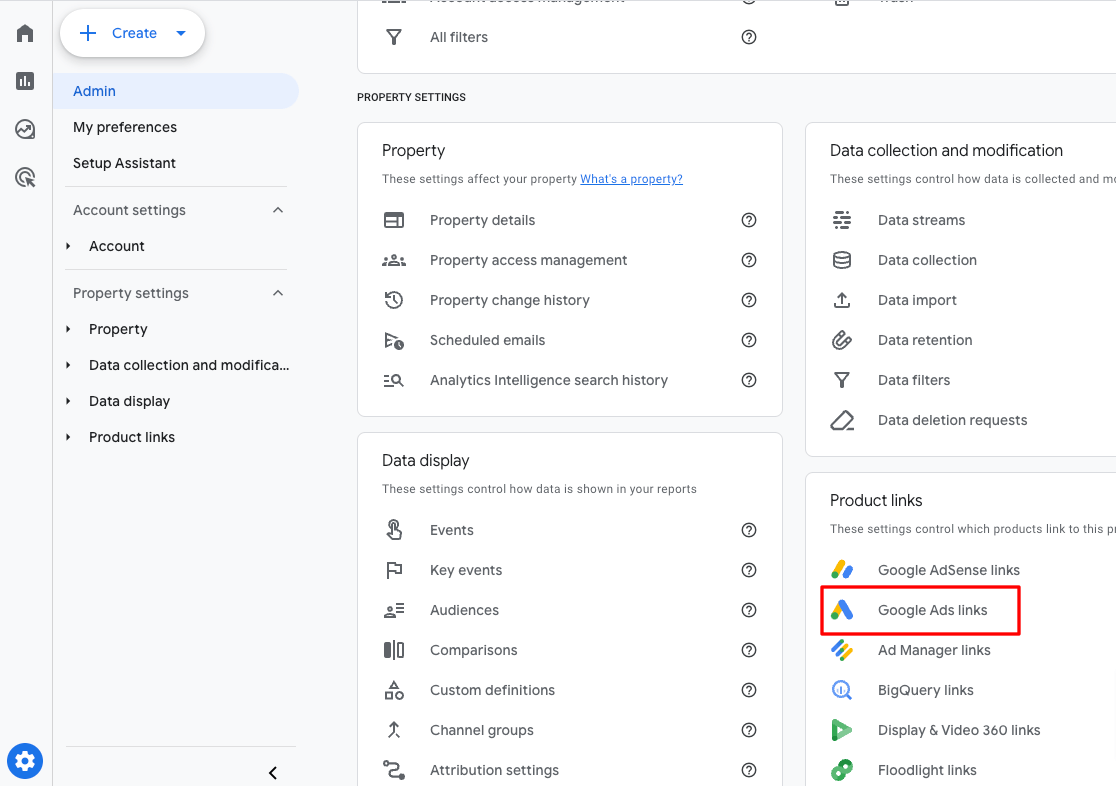
Now, you should see a screen that shows a list of Google Ads accounts that you are authorized to connect with. Place a check in the box next to the account where you manage ads for the selected website, then click Confirm.
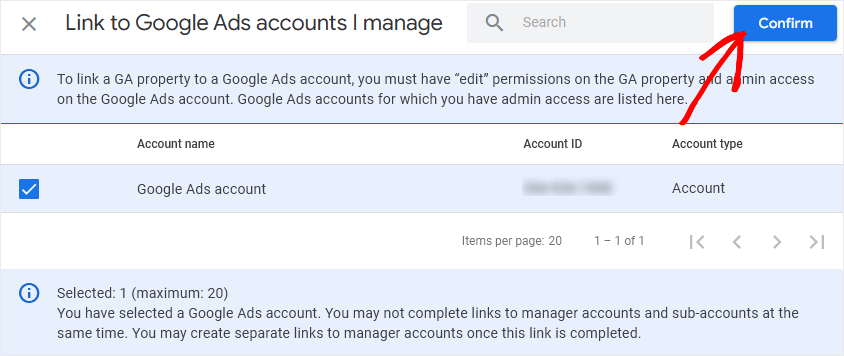
You’ll return to the previous window, where you now see the Google Ads account you selected for tracking conversions. At this point, you can click the Next button.
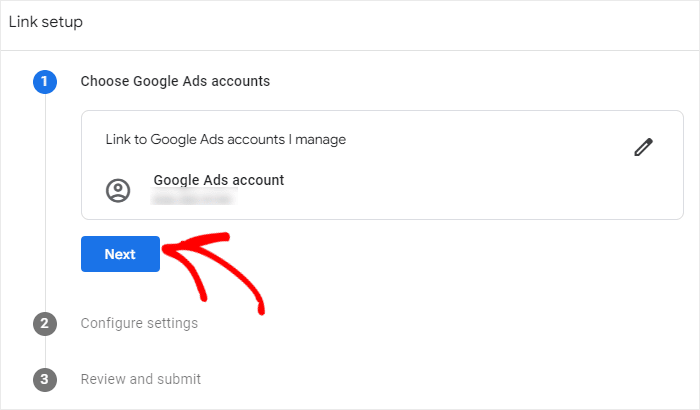
In the next step, you can leave all default settings as is and click Next again.
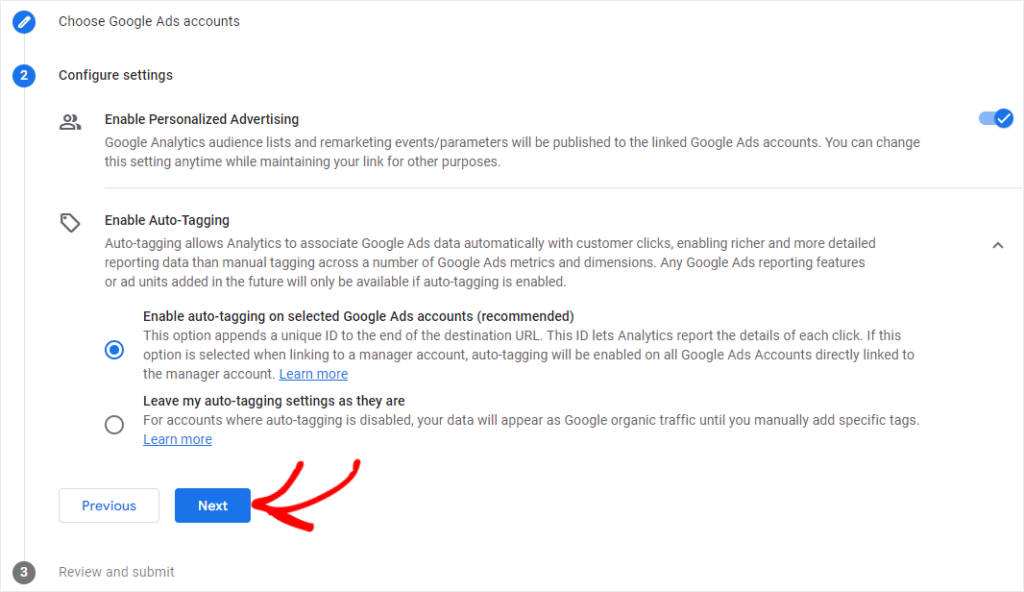
On the next step, simply check your settings and then click Submit.
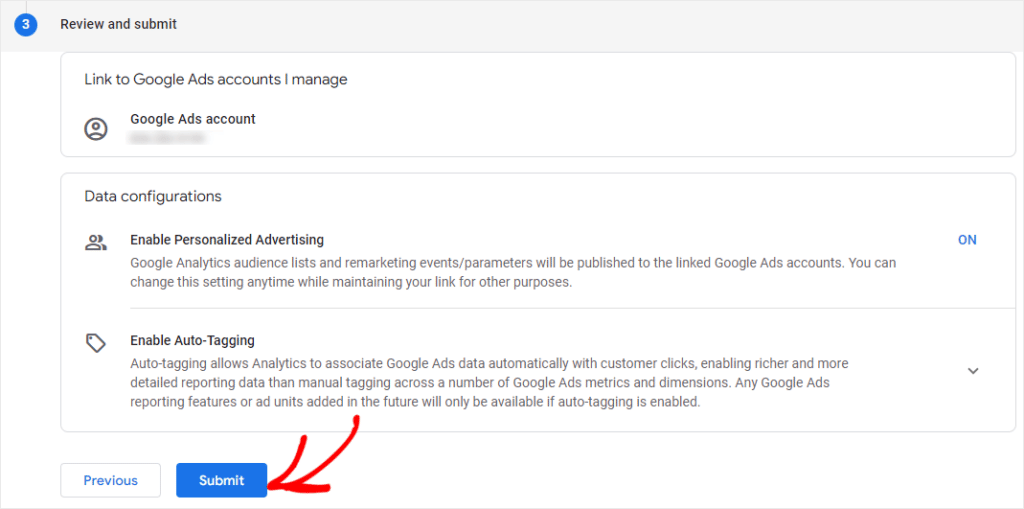
That’s it! Now your GA4 account is connected to Google Ads and can begin collecting more valuable data about your site traffic and ad conversions.
That’s it!
We hope this guide helped you to find out how to use Google Analytics for Google Ads conversion tracking on your WordPress website. To learn how to find Google Ads reports in Google Analytics, check out How to Find Google Ads Reports in Google Analytics.
Not using MonsterInsights yet? What are you waiting for?
And don’t forget to follow us on Twitter, Facebook and YouTube for more helpful reviews, tutorials, and Google Analytics tips.

Hey, thank you for sharing your knowledge. I wanted to know if this setup is possible through Google Tag Manager. If yes, then how? Which one is better? Actually, I am facing issues with 100% data accuracy for my clients.
Hi Saurya – it is possible to set up Google Ads conversion tracking in Google Tag Manager. We don’t provide support for Google Tag Manager, but try this article. It depends on how comfortable you are with using GTM.
Hello, is any way to add multible Google Ads Conversion ID and Conversion Label
i have 3 google ads account for one website
is this avaliable ?
Hi there – At this time, we only support one. If you need to add multiple, we recommend using WPCode.